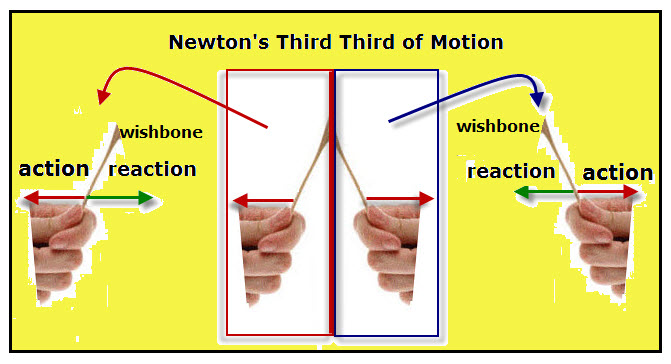The action/reaction pair of forces described in Newton’s Third Law of Motion
ALWAYS act on different objects.
One way to identify an action/reaction pair of forces is to describe them. If each description is the reverse of the other, then they are an action/reaction pair of forces. For Example: In the diagram, there are two pairs of action/reaction forces, one for the left side of the wishbone and one for the right side of the wishbone. The following describes either action/reaction pair of forces.
Action Force
The hand is applying a force on the wishbone end.
Reaction Force
The end of the wishbone is applying a force on the hand.
Newton’s Third Law of Motion states that for every action force, there is an equal reaction force in the opposite direction.
 With equal forces, why does the wishbone break?
With equal forces, why does the wishbone break?
The wishbone breaks when the action force of one of the hand is greater than the responding reaction force of the bone. Assuming the same action force is being applied by each hand, then the weakest side of the wishbone will break first. As shown on the diagram, the side that breaks is the smallest piece.
Who wins? The rules of the wishbone breaking contest must be determine before the contest begins. Some say the person with the shortest end is the winner, which others say the contestant with the longest end wins.
Science Challenge:
Are There Tricks To Winning? This I have no proof for. My guess is that if the winner has the shortest piece, a twisting action force might cause the bone to snap. If you have any winning tips you are willing to share, send them to me at:
Structu ral Engineers must be able to determine the action/reaction pairs of forces in structures. reaction of materials used in building structures. For information the job of structural engineers, see Forces that Affect Structural Engineers.
ral Engineers must be able to determine the action/reaction pairs of forces in structures. reaction of materials used in building structures. For information the job of structural engineers, see Forces that Affect Structural Engineers.
